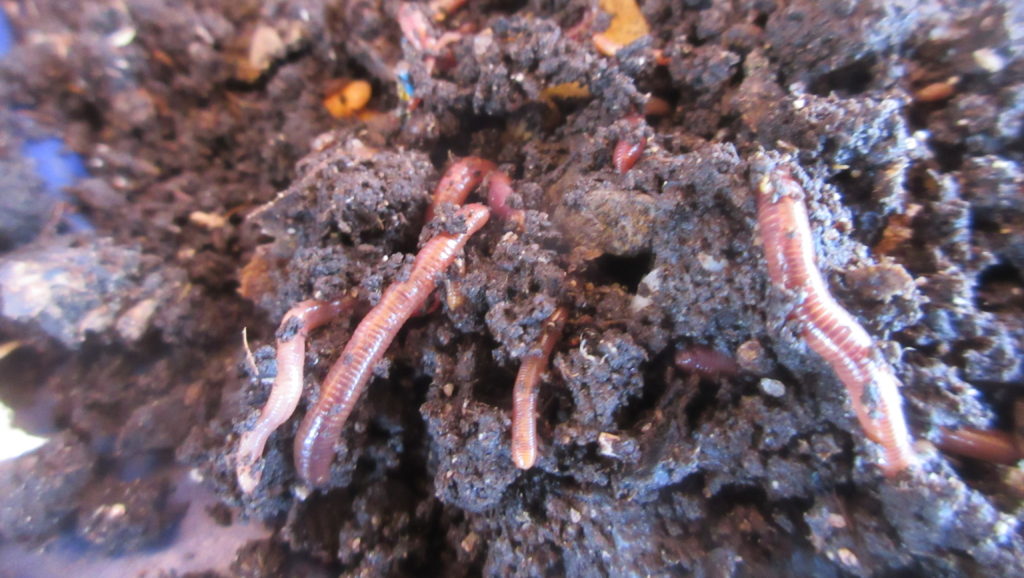“The worms are alive!” I practically sang upon confirming that red wigglers moved within cool, moist soil in my portable worm bin. They were laying low, nestled into their rich vermicompost rather than feeding. But they also weren’t massed together like on an earlier day this summer when the bin received full sun at the front edge of the porch. The shade from the porch pillar, into which I had moved them in June, helped. That the day “only” reached 107 degrees Fahrenheit helped too.
One hundred nine degrees. The threshold I learned in an awful way two summers ago. The point at which my worm bin failed on my back patio, where it received 4+ hours of direct sunlight each morning. The resulting mess of dead-worm-concentrated compost smelled bloody. Where I added it to the garden anyway, the color and aroma of iron seeped out for months. Maybe I imagined some, out of guilt. But the lesson of worms dying in the height of a Tucson summer was real.
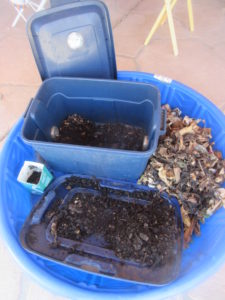
Back to the living worms! What is a calm, meditative pastime on a hot summer afternoon? Sifting worms out of a worm bin, for one. About a week after counting my blessings of worms surviving outside, I made time to move them inside. First, the flies had to go. That meant cleaning out the whole bin. Steps required:
- Get wading pool out of the shed.
- Set worm bin and various trays and containers in the (dry) pool.
- Remove bulky, partially decomposed newspaper and food pieces from bin. Add to regular compost.
- Remove gravel from bin (and decide not to replace it).
- Place a small amount of potting soil in a separate container.
- Handful by handful, place small mounds of vermicompost on a tray and use fingers to sift for worms. This is the feel-good part. For each glistening movement, remove a worm and place it in its temporary container. Repeat about 200 times.
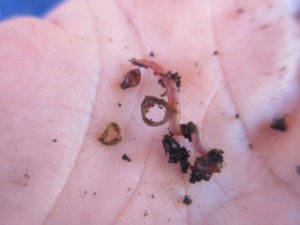
Young red wiggler worm, eggs, and an empty egg. - Look closely! Small brown balls are treasures too – eggs! They go with the worms.
- The squeamish may not be thrilled. Pill bugs, earwigs, and many, many tiny flies and mites emerge too. Add them to the bulky pile, leave them in the vermicompost, or simply let them fly/crawl away. Their presence is good for decomposition, bad for peace in my indoor home.
- Wash out worm bin, preferably where the water can drain to a plant or to other compost.
- Add a layer of moist, new potting soil that is rich for the worms but lacking other critters.
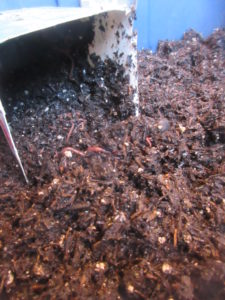
Worms and new potting soil in clean bin. - Tip the waiting worms into their clean bin.
- Add some kitchen scraps (preferably frozen first and without flies)
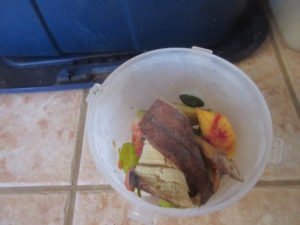
Clockwise from top: jalepeno pepper, banana peel, cucumber tip, nectarine pit. - Cover the soil, worms, and scraps with a loose layer of shredded newspaper for insulation, moisture retention, and supposed fly discouragement.
- Put lid on top and bring indoors!
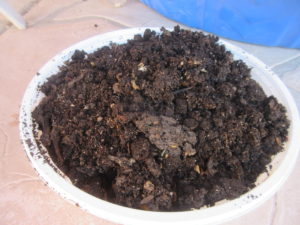
Remember the vermicompost? It’s how worms earn their keep – producing nutrient-rich, pH-balanced soil to use in the garden. (Read more reasons for worms at “Why Worms?”.) So the next day I split the vermicompost into two batches. One got spread into, then watered, for a dozen summer-weary pots. Direct fertilizing.
The other got bagged in an old t-shirt rag and clipped to the side of an available tub. I hosed in enough water to submerge most of the bag but left a couple inches for air. That got to sit overnight, brewing to a dark brown liquid and hopefully multiplying good microorganisms too. Compost tea. My 6-year-old liked monitoring the water’s color even though he had declined to help with worms the day before. Finally, the third morning since beginning this summer’s worm shenanigans, I gently poured the “tea” over the leaves of another dozen plants. I cannot say I have experimental evidence that this helps the plants’ health – a project for another season when I have a greater quantity of both time and plant stock. But it feels refreshing to feed the plants the cool liquid and some attention too. Thank you, worms, for small survival celebrations.

